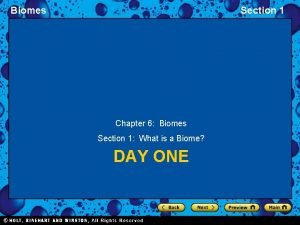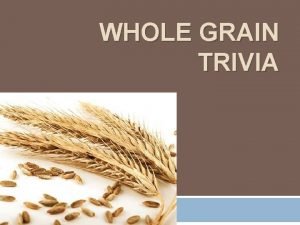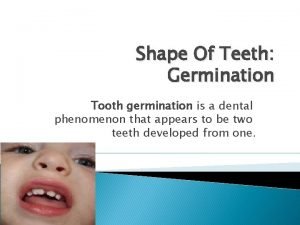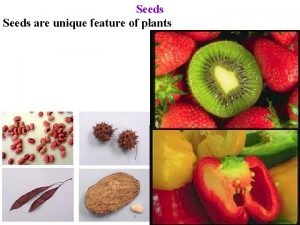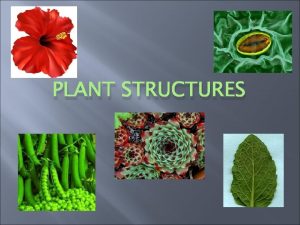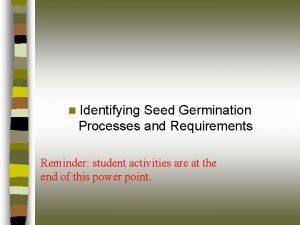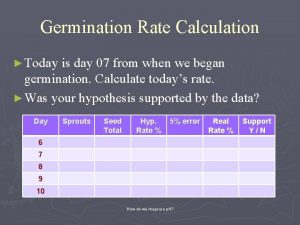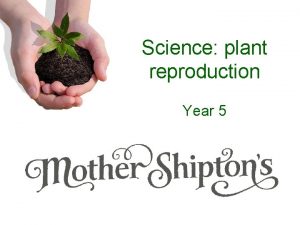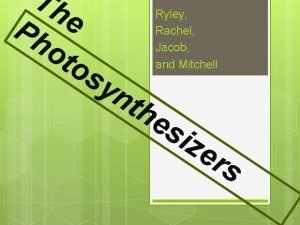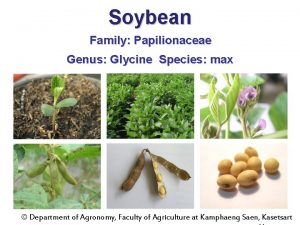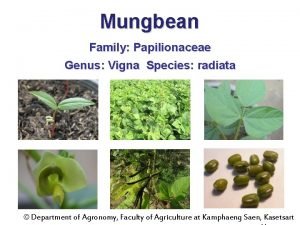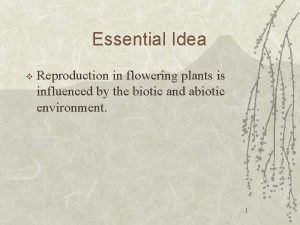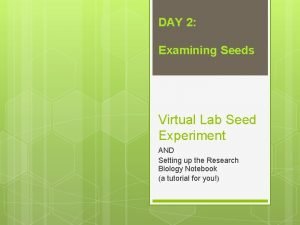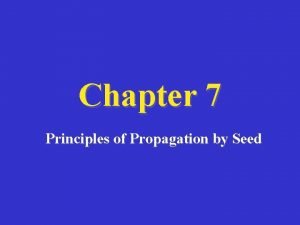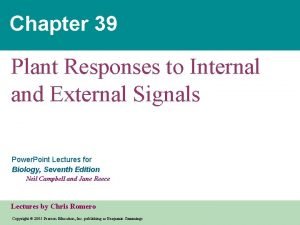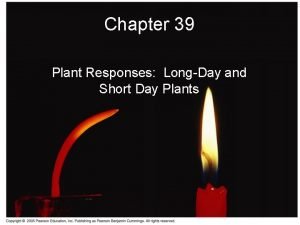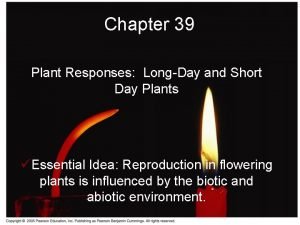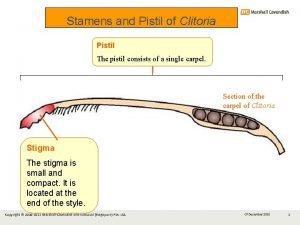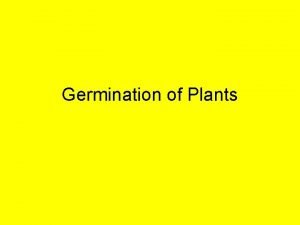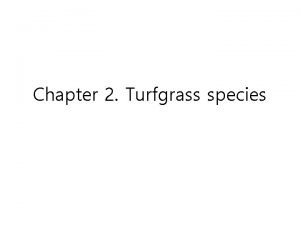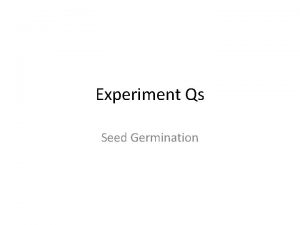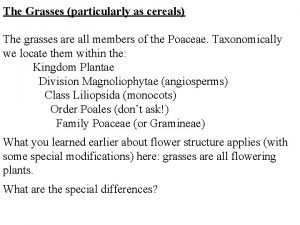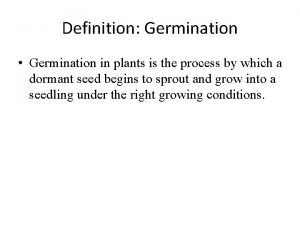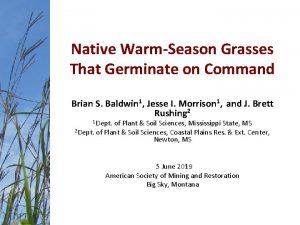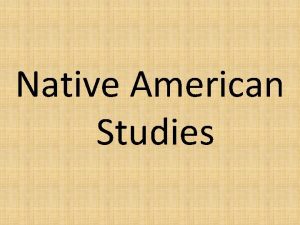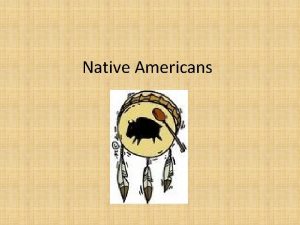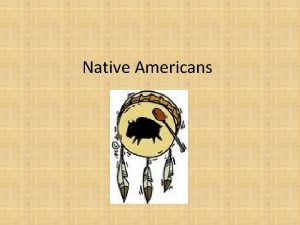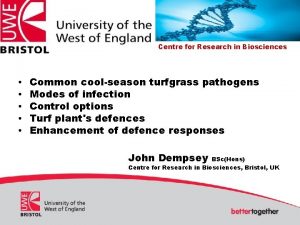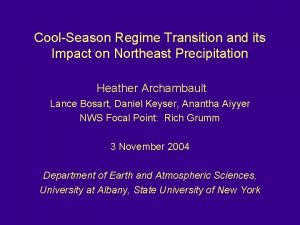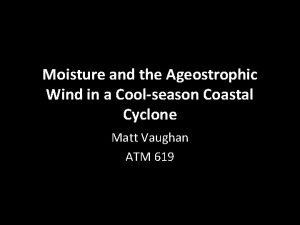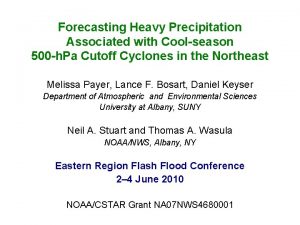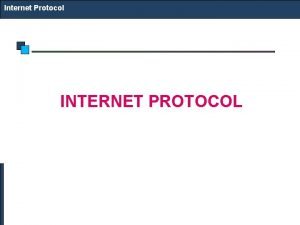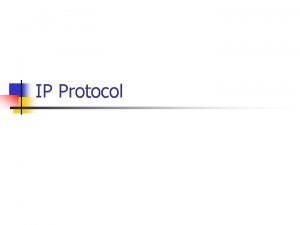GERMINATION PROTOCOL FOR THREE COOLSEASON NATIVE GRASSES ELYMUS





![Elymus elymoides ssp. brevifolius “SSP C” (SSP C) (a) Moore, Paula. 2014. [Photo] Elymus Elymus elymoides ssp. brevifolius “SSP C” (SSP C) (a) Moore, Paula. 2014. [Photo] Elymus](https://slidetodoc.com/presentation_image_h/301c934ad1cc069fa0cc9e60afb6cbe7/image-6.jpg)
![Elymus macrourus (ELMA 7) (a) Moore, Paula. 2014. [Photo] Elymus macrourus, USDA-ARS, Agriculture Experiment Elymus macrourus (ELMA 7) (a) Moore, Paula. 2014. [Photo] Elymus macrourus, USDA-ARS, Agriculture Experiment](https://slidetodoc.com/presentation_image_h/301c934ad1cc069fa0cc9e60afb6cbe7/image-7.jpg)
![Elymus wawawaiensis (ELWA 2) (a) Moore, Paula. 2014. [Photo] Elymus wawawaiensis, USDA-ARS, Agriculture Experiment Elymus wawawaiensis (ELWA 2) (a) Moore, Paula. 2014. [Photo] Elymus wawawaiensis, USDA-ARS, Agriculture Experiment](https://slidetodoc.com/presentation_image_h/301c934ad1cc069fa0cc9e60afb6cbe7/image-8.jpg)




















- Slides: 28

GERMINATION PROTOCOL FOR THREE COOL-SEASON NATIVE GRASSES: ELYMUS ELYMOIDES SUBSPECIES BREVIFOLIUS “Subspecies C” (SSP C), ELYMUS MACROURUS (ELMA 7), AND ELYMUS WAWAWAIENSIS (ELWA 2) Paula M. Moore MS in Agriculture, Research Thesis Referee Summary AOSA 2016 Meeting Portland, Oregon

Todays Topics Introduction Current published AOSA protocol Project Goal and Hypothesis Background: Why Elymus species? Research Design and Methodology Results AOSA New Rules Proposal Discussion References Cited Acknowledgements

Current AOSA Protocols for Elymus Kind of seed Substrate a Temp (o. C) Days first count Days final count Specific requirements and notes Elymus Canadensis P 15 -30 7 21 Light Elymus cinereus See Leymus cinereus P 15 -25 10 21 Fresh and dormant seed Prechill at 5 o. C for 2 wk Ungerminated seeds see sec. 6. 2 f and 6. 9 m Elymus elymoides P, B 15; 20 10 14 Ungerminated seeds see sec. 6. 2 f and 6. 9 m Elymus junceus See Psathrostachys juncea P 20 -30 5 14 Light Prechill at 5 or 10°C for 5 days Elymus smithii See Pascoyrum smithii B, P, T 15 -30 7 28 Dark Elymus trachycaulus subsp. trachycaulus P, TB 20 -30 5 14 Light Anonymous. 2014 a. AOSA. KNO 3 or soil. Ungerminated seeds: see sec. 6. 2 f and 6. 9 m Prechill at 5 o or 10 o. C for 5 d. If still dormant on 10 th day of germination period, rechill 2 d then place at 20 -30 o. C for 4 d

Project Goal and Hypothesis The goal of this research was to develop standardized germination protocols for three species of Elymus: SSPC, ELMA 7, and ELWA 2. It is hypothesized that Elymus elymoides subsp. brevifolius “SSP. C” will have the same germination protocol as Elymus elymoides subsp. Brevifolius (ELELB 2), which is currently published by AOSA (Anonymous, 2014 a). Temperatures for optimal germination will be 15 o. C or 20 o. C, blotter paper will be the substrate and water the moisture source (Anonymous, 2014 a). Elymus macrourus (Turcz. ex Steud. ) Tzvelev, POACEAE, will have a germination protocol with optimal viability at a constant temperature < 25 o. C with an 8 h light source. Elymus wawawaiensis (J. Carlson & Barkworth), POAECEA, Snake River wheatgrass will have an optimal viability at a constant temperature < 25 o. C. It is hypothesized that no dormancy breaking techniques will be necessary for any of these species, as members of the genus Elymus do not usually require such treatments. Light will be necessary for the germination of all three species. Statistical evaluation was based on a 95% Confidence Level (P < 0. 05).

Back Ground: Why Elymus species? Many uses of Elymus Ethnobotanical History Relative of Wheat Family Great Basin Restoration Project Economic Importance Production of Certified Seed Fields in Washington Reclamation and Restoration Uses Introduce the Plant Species: photographs
![Elymus elymoides ssp brevifolius SSP C SSP C a Moore Paula 2014 Photo Elymus Elymus elymoides ssp. brevifolius “SSP C” (SSP C) (a) Moore, Paula. 2014. [Photo] Elymus](https://slidetodoc.com/presentation_image_h/301c934ad1cc069fa0cc9e60afb6cbe7/image-6.jpg)
Elymus elymoides ssp. brevifolius “SSP C” (SSP C) (a) Moore, Paula. 2014. [Photo] Elymus elymoides ssp brevifolius “SSP C”, USDA-ARS, Agriculture Experiment Station of 13 Western States, Washington State University, Central Ferry, Washington. (b) Moore, Paula. 2014. [Photo] Elymus elymoides ssp brevifolius “SSP C”, Sample 3, PI 639790, Regenerated at Agriculture Experiment Station of 13 Western States, Washington State University, Central Ferry, Washington. (c) Granite Seed Company. 2015. [Photo] Elymus elymoides subspecies brevifolius “Subspecies C” (SSP C, Squirreltail), Lehi, Utah 84043 http: //www. graniteseed. com/products/seeds/elymus-elymoides (accessed 26 September 2015)
![Elymus macrourus ELMA 7 a Moore Paula 2014 Photo Elymus macrourus USDAARS Agriculture Experiment Elymus macrourus (ELMA 7) (a) Moore, Paula. 2014. [Photo] Elymus macrourus, USDA-ARS, Agriculture Experiment](https://slidetodoc.com/presentation_image_h/301c934ad1cc069fa0cc9e60afb6cbe7/image-7.jpg)
Elymus macrourus (ELMA 7) (a) Moore, Paula. 2014. [Photo] Elymus macrourus, USDA-ARS, Agriculture Experiment Station of 13 Western States, Washington State University, Central Ferry, Washington. (b) Moore, Paula. 2015 [Photo] Elymus macrourus, Sample 4, sfd-11 -11 pmc 148, Regenerated at Palmer Material Center, Alaska. (c) Moore, Paula. 2014. [Photo] Elymus macrourus, USDA-ARS, Agriculture Experiment Station of 13 Western States, Washington State University, Central Ferry, Washington.
![Elymus wawawaiensis ELWA 2 a Moore Paula 2014 Photo Elymus wawawaiensis USDAARS Agriculture Experiment Elymus wawawaiensis (ELWA 2) (a) Moore, Paula. 2014. [Photo] Elymus wawawaiensis, USDA-ARS, Agriculture Experiment](https://slidetodoc.com/presentation_image_h/301c934ad1cc069fa0cc9e60afb6cbe7/image-8.jpg)
Elymus wawawaiensis (ELWA 2) (a) Moore, Paula. 2014. [Photo] Elymus wawawaiensis, USDA-ARS, Agriculture Experiment Station of 13 Western States, Washington State University, Central Ferry, Washington. (b) Moore, Paula. 2015 [Photo] Elymus wawawaiensis, Sample 5, PI 506266, Regenerated at Central Ferry, Washington. (c) Moore, Paula. 2014. [Photo] Elymus wawawaiensis, USDA-ARS, Agriculture Experiment Station of 13 Western States, Washington State University, Central Ferry, Washington.

Research Design and Methodology Preliminary Experiment Split-plot nested design, temperature as the main plot and accession and seed source as subplots. Plot treatments were constant temperatures of 15 o. C, 20 o. C, and 25 o. C. The 432 samples (8 runs x 18 germination boxes x 3 chambers) had 431 degrees of freedom. An additional 9 th run without lights was done at the end. Germination box placement was randomized for each run with the use of an online tool (https: //www. randomizer. org/). For each sample, 50 seed were counted and placed in 5 rows of 10 seed on top of the moist blotter paper. A total of 1. 65 g of wetable powdered Captan 50% fungicide (Bonide Captan 50% WP Fungicide for Ornamentals and Fruit) was sprinkled over the seed.

Continued… Forceps were dipped in Waxie Green Neutral Cleaner® between samples to reduce the spread of seed coat-borne fungus. Moisture in the germination boxes was monitored daily by the “thumb indent test” for the moisture content of the blotter paper (Anonymous, 2014 b, Section 6. 3). Distilled water was added as necessary to maintain a moist blotter paper. Seedlings were evaluated on day seven (7 d), fourteen (14 d), twenty-four (24 d) and thirty-five (35 d) for normal seedlings, abnormal seedlings and dead seed. Testing was continued for an additional two days (2 d) if more than 10% of the imbibed seeds had not germinated on 35 d. Dead seed were removed from the moist blotter as needed at every evaluation and recorded. Results for Normal seedlings, Abnormal seedlings, dormant and dead seed were recorded on an excel spread sheet ELELB 2 was utilized as a check, we know from the published protocol how this species should react to temperatures.

Plant symbol Sample Id # Cultivar or Name Source Year ELMA 7 1 PI 531633 WRPIS, Pullman, WAi 1991 ELMA 7 2 sfd-09 -11 pmc 12 PMC, Palmer, AKii 2009 ELMA 7 4 sfd-07 -07 pmc 115 PMC, Palmer, AK 2007 ELMA 7 5 sgo-05 -05 PMC 138 PMC, Palmer, AK 2005 ELMA 7 6 sfd-11 -11 pmc 148 PMC, Palmer, AK 2011 ELWA 2 7 PI 440921, ‘Secar’ WRPIS, Pullman, WA 1982 ELWA 2 8 PI 506266, D&S-211 WRPIS, Pullman, WA 1988 ELWA 2 9 ‘Discovery’ USDA –FRRL, Logan, UTiii 2009 ELWA 2 10 ‘Discovery’ USDA –FRRL, Logan, UT 2011 ELWA 2 11 ‘Secar’ USDA –FRRL, Logan, UT 1995 ELWA 2 12 ‘Secar’ USDA –FRRL, Logan, UT 2003 i Western Regional Plant Introduction SSP C 13 ‘Grandview’ USDA –FRRL, Logan, UT 2000 Station [WRPIS]. SSP C 14 PI 639788, T-1202 WRPIS, Pullman, WA 2004 ii Plant Materials Center [PMC]. SSP C 15 PI 639790, T-1206 WRPIS, Pullman, WA 2004 ELELB 2 16 ‘Tusas’ PMC, Los Lumus, NMii 2008 ELELB 2 17 ‘Tusas’ PMC, Los Lumus, NM 2009 ELELB 2 18 ‘Tusas’ PMC, Los Lumus, NM 2006 iii USDA, Forest and Range Research Laboratory [FRRL].

Seed Analysis Seed Purity and Pure Seed Unit (PSU) Samples for the AOSA referee study were identified analyzed for pure seed unit (PSU), #21 definition of AOSA Rules for Testing Seed (Anonymous, 2014 b). The best fits the morphological structures of Elymus species. Seed analysts’ at the Washington State Department of Agriculture (WSDA) Seed Program used AOSA approved methods for purity analysis (Anonymous, 2014 b). A total of 450 PSU were analyzed and counted by hand placed into individual envelopes for distribution to referee participating laboratories. Seed Working Weights A total of 16 replicates of 100 PSU were counted, weighed and recorded for each seed lot. The mathematical equations for variance, standard deviation, and coefficient of variance were applied as directed in Section 13. 4. d (Anonymous, 2014 b). Data was used to estimate the minimum and maximum weights for Noxious Weed Exam, Purity Exam, and Working Weight Sample. Every species published in the AOSA Rules for Testing Seeds has a PSU definition and working weights.

Research Design and Methodology Referee Study A referee panel was established with four to seven laboratories. The referee for SSP C had four participants. The ELMA 7 had five participating laboratories. The ELWA 2 referee had seven participating laboratories. Split-plot, nested design with laboratory as the main plot and replicated samples as the subplot. Labs collected data on the number of seedlings counted as normal germination by AOSA published standards (Anonymous. 2014 b). The main parameter tested was number of normal seedlings on 7 d, 14 d, and 21 d among laboratories. The seed sources for the referee study included one fresh seed sample that was less than one year old. The fresh seed lots of SSP C and ELWA 2 were regenerated from seed stock during the 2013 -2014 growing season at the USDAARS, Central Ferry Research Farm. The regeneration harvest yielded no pure live seed of ELMA 7. The harvest was primarily of inflorescence with immature seed. Therefore, no fresh seed of ELMA 7 was available for the referee study.

Continued… The referee study procedures started with saturation of standard blotter paper with distilled water. A single saturated blotter paper was placed in a germination box. For each provided sample or seed source, a minimum of four replicates were placed in germination boxes and labeled for each species, sample number and replicate. The chamber temperature was established at a constant 20 o. C. Chamber temperatures were monitored to assure they were within +/-2 o. C of the targeted parameter. All germination boxes were monitored for the moisture content of the blotter paper. If seeds were determined as ungerminated by 21 d, they were held over for an additional 2 d of testing per AOSA rules (Anonymous, 2014 b). Following a 23 -day-test period, any remaining ungerminated seed were Tetrazolium tested (TZ) and calculated TZ viable results were added to the normal seedlings to get total viability.

Plant symbol Sample Id # Source Cultivar or Name Year SSP C 1 PI 639788 WRPIS, Pullman, WAi 2003 SSP C 2 PI 639788 USDA-ARS, Central Ferry Research Farm, WA 2014 SSP C 3 ‘Grandview’ USDA – FRRL, Logan, UTii 2000 ELMA 7 1 sgo-05 -05 pmc 138 PMC, Palmer, AKiii 2005 ELMA 7 2 sfd-07 -07 PMC 115 PMC, Palmer, AK 2007 ELMA 7 3 sfd-09 -11 pmc 12 PMC, Palmer, AK 2011 ELMA 7 4 sfd-11 -11 pmc 148 PMC, Palmer, AK 2011 ELWA 2 1 ‘Secar’ USDA – FRRL, Logan, UT 1995 ELWA 2 2 ‘Secar’ USDA – FRRL, Logan, UT 2003 ELWA 2 3 ‘Discovery’ USDA – FRRL, Logan, UT 2011 ELWA 2 4 PI 440921, ‘Secar’ USDA-ARS, Central Ferry Research Farm, WA 2013 ELWA 2 5 PI 506266 USDA-ARS, Central Ferry Research Farm, WA 2013 ELWA 2 6 ‘Secar’ USDA-ARS, Central Ferry Research Farm, WA 2014 i Western Regional Plant Introduction Station [WRPIS]. ii USDA, Forest and Range Research Laboratory [FRRL]. iii Plant Materials Center [PMC].

Results

Preliminary Experiment Results (P=0. 51) (P=0. 08) (P=0. 00) (P=0. 02) (P=0. 10) (P=0. 00) (P=0. 09) (P=0. 10)

(P=0. 40) (P=0. 38) (P=0. 43) (P=0. 36)

(P=0. 02) (P=0. 17) (P=0. 00) (P=0. 13)

* No significant difference between temperatures 15 OC and 20 OC for ELELB 2, SSP C, and ELWA 2 (P= 0. 01). ** No significant difference in all three temperature treatments for ELMA 7 (P =. 67).

Referee Study Results The question still remaining was, when should the evaluation period end? To assess this, a paired analysis (t-test) was performed on the data provided by the referee participants. Clarification on the data for referee study: Normal seedlings were the number counted at each day (14 d and 21 d) Viability on 14 d was a percentage of the normal seedlings Viability on 21 d was a percentage of normal seedlings PLUS the TZ viable Statistical analysis to identify if 21 d evaluation period was necessary.

Referee Summary (P < 0. 05) SSP C Number of Referee Laboratories 4 Paired Analysis 14 d - 21 d (paired t-test) Norm. replicates 14 d 34. 50% Norm. replicates 21 d 35. 88% Norm. pooled labs 95% Conf. Interv. 1. 39% Viability % replicates 14 d 24. 50% Viability % replicates 21 d 35. 88% Viability % pooled labs 95% Conf. Interv. 2. 75% (P=0. 05) Univariate Analysis of Difference Viability % pooled labs 7 d different (P=0. 0) Viability % pooled labs 14 d different (P=0. 0) Viability % pooled labs 21 d different (P=0. 01) Viability % pooled replicate (lab) 7 d same (P=0. 48) Viability % pooled replicate (lab) 14 d same (P=0. 37) Viability % pooled replicate (lab) 21 d same (P=0. 50) Viability % pooled samples 7 d different (P=0. 0) Viability % pooled samples 14 d different (P=0. 0) Viability % pooled samples 21 d different (P=0. 0) Viability % lab*sample 7 d different (P=0. 0) Viability % lab*sample 14 d different (P=0. 0) Viability % lab*sample 21 d different (P=0. 0) ELMA 7 5 7. 36% 14. 06% 5. 28% 7. 36% 14. 06% 11. 13% (P=0. 02) different (P=0. 0) same (P=0. 10) same (P=0. 47) same (P=0. 46) same (P=0. 53) different (P=0. 0) different (P=0. 01) ELWA 2 7 63. 89% 65. 16% 0. 44% 63. 89% 65. 16% 0. 69% (P=0. 00) different (P=0. 0) same (P=0. 20) same (P=0. 70) same (P=0. 08) different (P=0. 0) different (P=0. 02) different (P=0. 0)

AOSA New Rules Proposal A new AOSA rule proposal was submitted electronically on 15 Oct. 2015 to the AOSA New Rules Committee. SSP C: 20 C, first count 7 d, final count 14 d, 8 h light. ELMA 7: 20 C, first count 7 d, final count 21 d, 8 h light. ELWA 2: 20 C, first count 7 d, final count 14 d, 8 h light. A blind committee panel comprised of ten AOSA members reviewed the proposal and supporting evidence. The Committee rejected the proposal for SSP C, indicating the AOSA Rules for Testing Seeds were not intended to accommodate the subspecies level. It was recommended to discard the SSP C information and edit the proposal for the final rule proposal to the general membership. The raw data and analysis in support of the requirement of light was requested. A statistical analysis of the germination data without light was not performed. One run of the experiment was conducted without lights. This limited data would not provide sufficient degrees of freedom for a comparative analysis. The use of 8 h standard light was dropped from the rule proposal verbiage. The rule proposal was edited as suggested and resubmitted on 31 Jan. 2016 to the AOSA Rules Committee Chair.

Sample Definitions Working Weights Pure seed unit # Chaffy seed Kind of seed Minimum weight Approximate weight for Noxiousnumber of Purity weed seed or seeds per seed per ounce Analysis bulk gram (number) (grams) examination (number) (grams) 21 Yes Elymus macrourus Tufted Wheatgrass 8 83 260 – 322 (291) 21 Yes Elymus wawawaiensis Snake River Wheatgrass 9 84 227 - 384 (305) Pure Seed Unit (PSU) #21 definition of AOSA (Anonymous. 2014 c). 8415 - 8873 (8644) 6649 - 10463 (8556)

Discussion The proposed new rules for ELMA 7 and ELWA 2 as resubmitted for review are “reasonable” and similar to other Elymus species currently published within AOSA Rules for Testing Seeds (Table 6 A; Anonymous, 2014 b). ELMA 7: 20 C, first count 7 d, final count 21 d ELWA 2: 20 C, first count 7 d, final count 14 d The calculated working weights are similar to other Elymus species published within ASOA Rules for Seeds Testing (Table 2 A; Anonymous. 2014 b) and the Federal Seed Act Regulations (Anonymous, 2001). ELMA 7 had a Purity Analysis weight = 8 g, Noxious-weed seed exam = 84 g, approximate number of seed per gram = 291, and approximate seed per ounce = 8644 seeds. ELWA 2 replicated weights were used to calculate a Purity Analysis weight = 9 g, Noxiousweed seed exam = 84 g, approximate number of seed per gram = 305, and approximate seed per ounce = 8556 seeds.

Conclusions The addition of Elymus macrourus (ELMA 7, Northern wheatgrass) and Elymus wawawaiensis (ELWA 2, Snake River wheatgrass) germination standards to the AOSA Rules for Testing Seeds will establish uniformity among native grass seed laboratories. If the genus Elymus elymoides ssp. brevifolis “SSP. C” is reevaluated and changes in taxonomic nomenclature and results in it no longer being a subspecies, it could later be included within the protocol.

References Cited Anonymous. 2001. Federal Seed Act. Code of Federal Regulations. Title 7 – Agriculture. Volume: 3. Date: 2012 -01 -01. Original Date: 2012 -01 -01. Title: SUBCHAPTER K - FEDERAL SEED ACT Context: Title 7 - Agriculture. Subtitle B - Regulations of the Department of Agriculture. CHAPTER I - AGRICULTURAL MARKETING SERVICE, DEPARTMENT OF AGRICULTURE. SUBCHAPTER K—FEDERAL SEED ACT. PART 201—FEDERAL SEED ACT REGULATIONS, 201. 46 Weight of working sample. http: //www. gpo. gov/fdsys/pkg/CFR-2012 -title 7 -vol 3/xml/CFR-2012 -title 7 -vol 3 -subtitle. B-chap. Isubchap. K. xml#seqnum 201. 46 (accessed 25 September 2015). Anonymous. 2014 a. AOSA. [CD] Association of Official Seed Analysts, Inc. AOSA Rules for Testing Volume 1. Table 2. Principles and Procedures AOSA, 1601 52 nd Avenue, Suite #1, Moline, IL. Seeds Anonymous. 2014 b. AOSA. [CD] Association of Official Seed Analysts, Inc. AOSA Rules for Testing Volume 1. Principles and Procedures AOSA, 1601 52 nd Avenue, Suite #1, Moline, IL. Seeds Anonymous. 2014 c. AOSA. [CD] Association of Official Seed Analysts, Inc. AOSA Rules for Testing Volume 1. Table 3 A. Principles and Procedures. AOSA, 1601 52 nd Avenue, Suite #1, Moline, IL. Seeds

2011 -2016 Acknowledgements Committee Members: Dr. Richard T. Koenig, Chair; Vicki Bradley, M. S; Dr. William J. Johnston
 What three circumstances hurt native american
What three circumstances hurt native american Panicoid grasses
Panicoid grasses Chapter 6 biomes section 1 what is a biome
Chapter 6 biomes section 1 what is a biome Marine ecosystem dominated by marsh grasses
Marine ecosystem dominated by marsh grasses Multigrain breads are always whole-grain true or false
Multigrain breads are always whole-grain true or false Grass awns dogs
Grass awns dogs Grass inflorescence
Grass inflorescence Dicot seed germination diagram
Dicot seed germination diagram Tooth germination
Tooth germination Observation of seed germination day by day
Observation of seed germination day by day Seed maturation
Seed maturation Day by day seed germination observation chart
Day by day seed germination observation chart Conclusion of seed germination
Conclusion of seed germination Dicot seed germination diagram
Dicot seed germination diagram Labeled bean seed diagram
Labeled bean seed diagram Germination percentage calculator
Germination percentage calculator Pollination fertilisation seed dispersal germination
Pollination fertilisation seed dispersal germination Conclusion of seed germination
Conclusion of seed germination Epigeal germination
Epigeal germination Diadelphous stamen
Diadelphous stamen About germination
About germination Seed germination
Seed germination Seed germination virtual lab
Seed germination virtual lab Hypogenous germination
Hypogenous germination Seed germination
Seed germination Seed germination
Seed germination Seed germination
Seed germination Factors affecting seed germination ppt
Factors affecting seed germination ppt Clitoria is a bisexual flower. what does that mean?
Clitoria is a bisexual flower. what does that mean?


